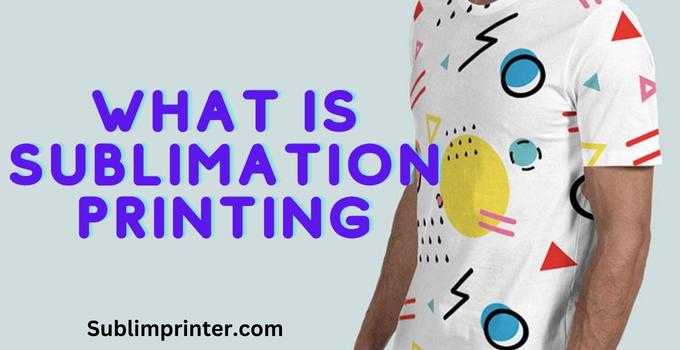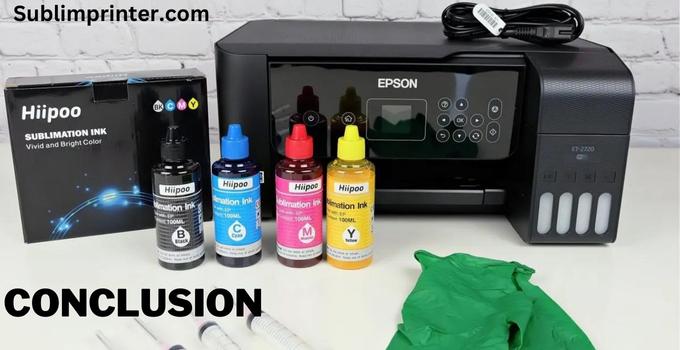You just got a printer for converting to sublimation printing. You are so excited about it, but don’t know where to begin. Did you ever wonder how to convert a printer to sublimation?
Sublimation is an advertising technique where a print surface is heated to change a solid (ink, dye, etc.) into a gas and then transferred to an item. Sublimation printing is used in various industries such as promotional products, clothing, and many others.

There are lots of methods How to Convert a Printer to Sublimation? Learn all about them and why you should convert your printing process in this article!
If you’re wondering how to convert a printer, this is the article you’ve been looking for. All of your questions will be answered in the following paragraphs.
What is sublimation printing?

Sublimation printing is a process by which ink is transferred to a polyester film, fabric, or other substrates. The ink becomes part of the material, resulting in an image that is durable and resistant to fading.
Sublimation printing is commonly used for printing on T-shirts, but the technology has been applied to all sorts of products, including mugs, mouse pads, and even musical instruments.
The process involves heating a sheet of paper or plastic until it turns into gas. Then the gas cools back down and condenses into liquid. This causes the color pigments in the paper to move from solid crystals into liquid form. When they cool back down again into solid crystals, they become trapped in the paper fibers (or other material).
The sublimation process uses heat to transfer an image onto the garment. The sublimation printing machine heats up a special ribbon (the part of the printer that transfers the image), which is then applied to the fabric. The dye in the ribbon then melts and adheres to the fabric, creating a durable print that will not fade or crack over time.
A sublimation printer is specifically designed for this type of printing, with the ability to convert both vector and raster images into sublimated images. The result is that you can print any image you want onto your products without worrying about it fading or changing color over time.
The process of converting an image to sublimation involves using special software that enables you to use an existing printer to create sublimated prints instead of just normal prints.
Benefits of Sublimation Printing

Sublimation printers use a ribbon of ink instead of individual drops of ink to create an image on a piece of fabric. This ribbon is made up of tiny dyes that are sensitive to heat. When these dyes are exposed to heat, they melt and mix with the fabric fibers which causes them to permanently stain the fabric with the image you want on it.
Make sure your printer supports sublimation. If it doesn’t have this ability, then there’s no point in trying it out unless you want to use it as an ordinary printer too (which defeats the purpose).
Durability
The quality of sublimation printing makes it very durable against even the harshest conditions. This means that your designs will last longer than they would if they were printed with traditional methods such as screen printing or lithography. In addition to its durability, sublimation can be printed onto various surfaces including glass, metal, plastic, and paper!
Flexibility
You have more design flexibility with sublimation printing than with other forms of printing because you can use multiple colors without having to worry about mixing them together or using different materials for each color (like ink). You can even use the same image on multiple products if needed! For example, if you have one image that needs to be printed on four different items (such as shirts).
High quality
Because digital images are printed directly onto a substrate instead of being transferred through an intermediate layer like traditional offset lithography, sublimation prints produce clear images with rich colors and sharp contrast.
Sublimation prints are waterproof
Most sublimation inks are water-based, meaning they don’t wash out when exposed to water or moisture like many other types of screen-printing inks do. This makes them ideal for use on garments that will be worn in wet conditions like raincoats, jackets and umbrellas.
You can print large quantities
Sublimation printers print up to six times faster than traditional screen printers and enable you to print large quantities at once — perfect for bulk orders.
The difference between Heat Transfer Paper and Sublimation Printing

The main difference between photograph and sublimation printing is the ink used to print. Sublimation ink is used in sublimation printing and this ink changes from liquid to solid form when it comes in contact with heat. This type of printing is also known as dye sublimation because the ink does not leave any residue on the surface of the fabric.
Photograph printing uses ink that leaves a residue on the surface of the fabric. The image in this type of printing is created using a screening process.
The screen can either be made from metal or plastic materials, which are then used to block light from passing through them. The effect produced by this method results in an image that appears flat and uninteresting compared to those produced by sublimation printing methods.
Photograph Printing
Photograph printing uses photographic paper which is coated with light-sensitive chemicals. When exposed to light, the chemicals change color to form an image. The paper is soaked in water to develop the image.
Sublimation Printing
Sublimation printing uses heat to transfer ink onto a surface. Sublimation printing is the most popular and versatile printing method. You can print on most fabrics and materials, including natural fibers, synthetics, plastics and metal.
How to convert a regular printer to a sublimation printer

Sublimation is a process that uses heat to transfer a special ink to a shirt. The ink is then cured with heat, giving it a permanent bond with the garment. It’s an affordable way to print large quantities of shirts, but the equipment required for sublimation printing can be expensive. If you have a printer that isn’t capable of sublimation printing and want to convert it, here are six simple steps:
- Buy a sublimation printer
The first step is to buy a sublimation printer. A sublimation printer is used for printing images on fabric. The most popular brands of sublimation printers are Epson and Canon.
- Remove the ink cartridge
Once you have bought a new printer, remove the ink cartridge from it so that you do not damage it during the conversion process. Take care not to touch the electrical contacts on either side of the cartridge as these are very delicate and will be damaged easily if touched by bare hands or any other object that might cause static electricity build-up.
- Install the sublimation tray
The conversion kit comes with instructions on how to install the tray in your printer model. If you’re not sure where to install it, consult your manual or call the manufacturer.
- Install the sublimation ink cartridge
This step is optional if you have a new printer that doesn’t require an additional cartridge, but most printers require one or two extra cartridges for sublimation printing. Consult your instruction manual for details about installing the cartridge(s).
- Set up your computer and software
If you have a Windows PC, download the latest version of Adobe Photoshop Elements or the full version of Photoshop. Mac users should choose between Adobe Photoshop Elements and Adobe Photoshop. If you’re using a Mac, make sure that you have the latest version of Adobe PhotoShop Elements.
- Print your first design
Next, download a sublimation-friendly image from the Internet and print it out on your printer/inkjet/sublimation machine. The best results will be obtained if you use a black-and-white image with high contrast (a photo like this works well). If you’re unsure about how to get started, try searching for “sublimation transfer paper” on Google Images or Bing Images to find some examples of black-and-white designs that work well with sublimation transfer paper.
Conclusion: How to Convert a Printer to Sublimation

Sublimation has been around for nearly half a century, and it’s still one of the best ways to get your images onto fabric. If you ever liked the look of sublimated clothing but didn’t want to pay the high cost of buying that garment or t-shirt outright –sublimation is an excellent solution. And what was once a complicated and costly process can now be accomplished relatively easily, thanks to newer sublimation kits. If you want to know How to Convert a Printer to Sublimation printing, follow this guide. We are confident that your questions have been answered and that you have all of the information you need in order How to Convert a Printer to Sublimation. If you can afford to, we would encourage purchasing a new printer with the proper settings. Doing so removes the guesswork and ensures that you get great quality every time. You can use this article or another online source to help determine which printers are best for this task.
